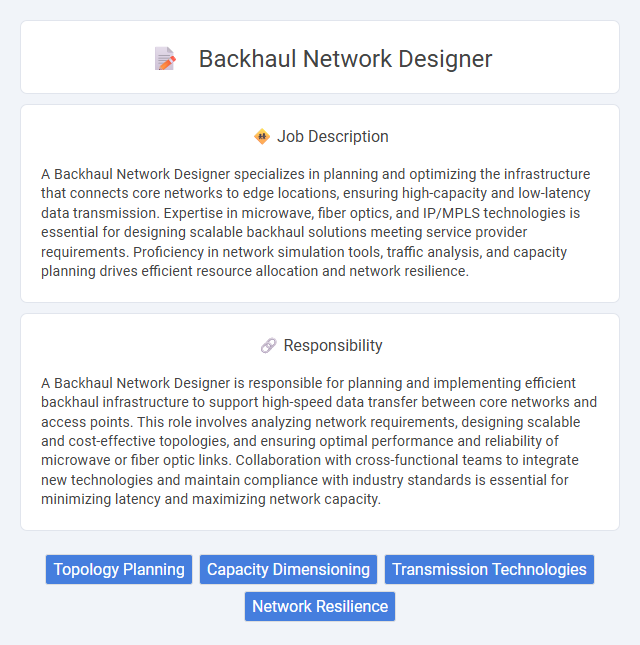
A Backhaul Network Designer specializes in planning and optimizing the infrastructure that connects core networks to edge locations, ensuring high-capacity and low-latency data transmission. Expertise in microwave, fiber optics, and IP/MPLS technologies is essential for designing scalable backhaul solutions meeting service provider requirements. Proficiency in network simulation tools, traffic analysis, and capacity planning drives efficient resource allocation and network resilience.
Individuals with strong analytical skills and a passion for telecommunications are likely suitable for a Backhaul Network Designer role. Those comfortable working in fast-paced environments involving complex problem-solving may adapt well to designing and optimizing network infrastructure. People who prefer routine tasks with minimal technical challenges might find this position less compatible with their skills and interests.
Qualification
A Backhaul Network Designer requires expertise in telecommunications, network architecture, and RF engineering, along with proficiency in tools like GIS and network simulation software. Strong analytical skills, experience with 4G/5G technologies, and knowledge of fiber optic and microwave backhaul solutions are crucial. Certifications such as CCNP, RF Engineering, or similar credentials enhance qualifications.
Responsibility
A Backhaul Network Designer is responsible for planning and implementing efficient backhaul infrastructure to support high-speed data transfer between core networks and access points. This role involves analyzing network requirements, designing scalable and cost-effective topologies, and ensuring optimal performance and reliability of microwave or fiber optic links. Collaboration with cross-functional teams to integrate new technologies and maintain compliance with industry standards is essential for minimizing latency and maximizing network capacity.
Benefit
Benefits of a Backhaul Network Designer role likely include competitive salary prospects due to specialized technical skills and high demand in telecommunications. Candidates may enjoy career growth opportunities driven by the expanding need for efficient data transmission infrastructure. Job satisfaction could stem from the ability to influence network performance and reliability through innovative design solutions.
Challenge
Backhaul Network Designers likely face the challenge of optimizing network capacity and coverage while managing limited physical infrastructure and budget constraints. They probably need to address complexities related to geographic terrain, interference, and evolving technology standards to ensure reliable high-speed connectivity. Navigating these technical and logistical obstacles is expected to require advanced analytical skills and innovative planning approaches.
Career Advancement
Backhaul Network Designer roles require expertise in optimizing data transport systems for telecommunications, enabling seamless connectivity for large-scale networks. Mastery of fiber optics, microwave transmission, and routing protocols enhances eligibility for senior network architect or project management positions. Advancing in this career involves certifications such as CCNP or specialized training in 5G backhaul systems, driving professional growth in an increasingly digital infrastructure landscape.
Key Terms
Topology Planning
Backhaul Network Designers specialize in topology planning to optimize the connectivity between core networks and access points, ensuring efficient data transmission and minimal latency. They analyze geographic data, traffic patterns, and infrastructure capabilities to design robust, scalable network topologies that support high-capacity backhaul links. Expertise in microwave, fiber optics, and hybrid network technologies enables them to create cost-effective, resilient network backhaul structures tailored to diverse deployment scenarios.
Capacity Dimensioning
Backhaul Network Designer specializing in Capacity Dimensioning is responsible for modeling and forecasting network traffic to ensure efficient data flow between core and edge networks. They analyze bandwidth requirements, optimize transmission paths, and deploy scalable infrastructure to support growing user demands and maintain high-quality service levels. Expertise in traffic engineering, network protocols, and capacity planning tools is essential to balance load and prevent congestion across fiber, microwave, or satellite backhaul systems.
Transmission Technologies
Backhaul Network Designers specialize in optimizing transmission technologies to ensure efficient data transport between core networks and access points. They leverage microwave, millimeter-wave, and fiber optic solutions to enhance bandwidth capacity, reduce latency, and maintain network reliability. Expertise in protocols such as SDH/SONET, OTN, and IP/MPLS is essential for designing resilient and scalable backhaul infrastructures.
Network Resilience
Backhaul Network Designer specializes in optimizing the infrastructure that connects core networks to edge networks, ensuring robust and resilient data transmission paths. They implement redundancy protocols, diverse routing strategies, and failover mechanisms to maintain network availability and minimize downtime during outages or hardware failures. Expertise in designing scalable backhaul architectures strengthens overall network resilience against increasing traffic demands and evolving technological challenges.
 kuljobs.com
kuljobs.com